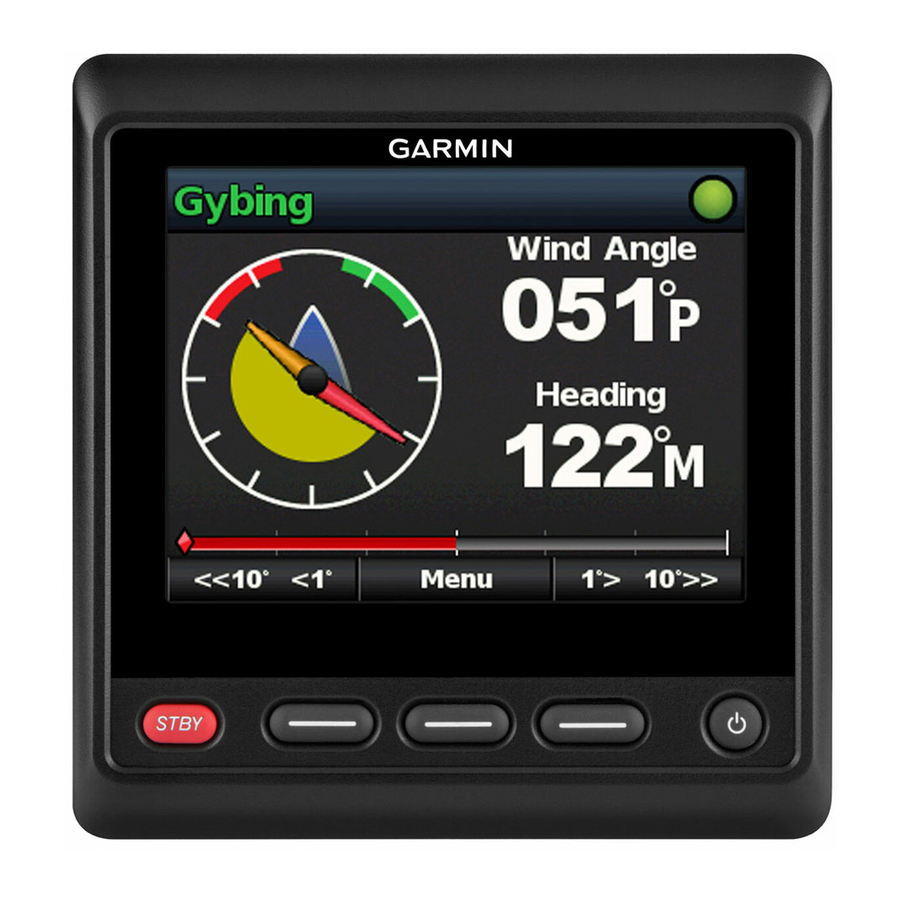Garmin GHC 20 Kullanıcı El Kitabı - Sayfa 6
Denizcilik Ekipmanları Garmin GHC 20 için çevrimiçi göz atın veya pdf Kullanıcı El Kitabı indirin. Garmin GHC 20 8 sayfaları.
Ayrıca Garmin GHC 20 için: Kullanıcı El Kitabı (13 sayfalar)

The autopilot steers your boat through a tack or gybe, and
"Tacking" displays on the heading screen until the maneuver
is complete.
Tacking and Gybing from Wind Hold
Before you can engage wind hold, you must have a wind sensor
installed.
1
Engage wind hold
(page
2
Select Menu > Tack/Gybe.
3
Select TACK or GYBE.
The autopilot steers your boat through a tack or gybe, and
information about the progress of the tack or gybe appears
on the screen.
Setting a Tack and Gybe Delay
The tack and gybe delay allows you to delay steering a tack and
gybe after you initiate the maneuver.
1
Select Menu > Setup > User Autopilot Setup > Sailing
Configuration > Tack/Gybe Delay.
2
Select
or
to determine the length of the delay (from 0 to
15 seconds).
3
Select Done.
Enabling the Gybe Inhibitor
NOTE: The gybe inhibitor does not prevent you from manually
performing a gybe using the helm or step steering.
The gybe inhibitor prevents the autopilot from performing a
gybe.
1
Select Menu > Setup > User Autopilot Setup > Sailing
Configuration > Gybe Inhibitor.
2
Select Enabled.
Device Configuration
User Autopilot Settings
Select Menu > Setup > User Autopilot Setup.
Power Mode: Sets the device power mode to normal or
economy mode. Economy power mode allows you to set the
percentage of power used to run the autopilot.
Power Saver: Controls the aggressiveness of the autopilot. The
autopilot makes fewer adjustments in power saver mode.
Configuring the Remote Control
NOTE: The Garmin quatix™ watch can be configured to act as a
remote control for the helm control. See the instructions that
came with the watch for more information.
You can connect one optional remote control to the helm
control.
Select Menu > Setup > Remote.
Searching for a Remote Control
Select Menu > Setup > Remote > Search for Remote.
Pairing a Remote
1
Search for a remote control
2
Begin pairing the remote control according to the instructions
that came with that accessory.
A message appears on the helm control after the remote has
been paired successfully.
3
Select Connect.
4
3).
(page
4).
Assigning Remote Button Actions
If you assign a pattern to a button on the remote control,
remember that you are responsible for the safe operation of
your boat. Do not begin a pattern until you are certain the water
is clear of obstacles.
NOTE: If you assign direction control functionality to a button on
the remote, the autopilot must be in standby mode to change
the direction (forward or reverse).
1
Select Menu > Setup > Remote.
2
Select a remote button to assign an action to.
3
Select a button action.
4
If necessary, repeat steps 2 and 3 for the remaining buttons.
Disconnecting a Remote Control
1
Select Menu > Setup > Remote.
2
Select Disconnect Remote.
Display Settings
Select Menu > Setup > Display.
Color Mode: Sets the device to display day or night colors.
Configure Colors: Sets the color configuration for each color
mode. For day color mode, you can select a full color or high
contrast color configuration. For night color mode, you can
select a full color, red and black, or green and black color
configuration.
Backlight: Sets the backlight level.
Network Sharing: Allows you to share color mode, color
configuration, and backlight settings with other devices
across the NMEA 2000 network.
System Settings
Select Menu > Setup > System.
Units: Sets the units of measure.
Heading: Sets the reference used in calculating heading
information.
Variance: Adjusts the variance from true north. This setting is
only available when the heading is set to True.
Beeper: Sets if and when audible sounds are used.
Auto Power: Enables the device to turn on automatically when
the NMEA 2000 network turns on.
GHC Low Volt. Alarm: Sounds an alarm when the voltage of
the power supply connected to the device drops below a
specified level.
Language: Sets the on-screen language.
Operating Mode: Allows you to set the operating mode to
normal or store demo mode.
System Information: Allows you to view software information.
Factory Defaults: Resets the unit to factory defaults.
CAUTION
Device Configuration
